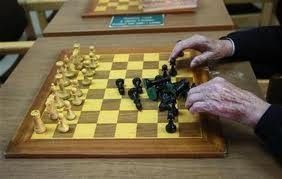Chess Experts Are Better at Viewing Game Boards, Faces and Other Visual Information: Study
Play Chess For Better Visual Processing

Researchers at the School of Behavioral and Brain Sciences (BBS), University of Texas (UT), have endorsed that a game of chess definitely broadens an individual's outlook in processing visual information.
Through three recent papers, the researchers have discussed how an expert chess player has the capability to analyze a chess board better, a trait that is seen in people who pay attention to new or familiar faces.
This new insight is seen as a method to unravel new techniques to improve eyewitness testimony. The research is seen as a tool to enhance teaching methods to enhance people's ability to learn more efficiently.
Cognitive neuroscientists at UT are studying gaming tactics of expert chess players who scrutinize a board to calculate their next moves. The aim is to understand how the brains of these chess players work, especially in processing visual information.
The behavioral findings, published in the Journal of Experimental Psychology, involved nearly 30 UT Dallas chess team members beginning in 2009.
Recreational players from the school's chess club and novice student participants too volunteered for the study. Part of the research is ongoing at UT Dallas' Center for Brain Health.
Study participants had to view a series of interleaved chess game boards and faces, noting whether each presentation matched the previous game position or face.
With faces, lead researcher James Bartlett, Dr. Daniel Krawczyk and co-author Amy Boggan found that casual chess players and novices exhibited a so-called congruency effect which is a hallmark of face processing. But expert chess players demonstrated a harmonizing effect with chess, which suggested that they process chess games more holistically than less-experienced players.
In another study, the researchers used functional magnetic resonance imaging (fMRI) to map the reactions inside the players' brains when they viewed faces, chess positions, randomized chess positions and other objects.
The scientists observed that typical brain areas usually associated with face recognition were not particularly responsive to chess game displays but, certain areas of the brain were seen to be sensitive to game moves. These brain areas actually scrutinized whether games were normal games or had pieces randomly placed about the board.
The new study is seen as a precursor to further investigations for understanding how the brains of chess players react to certain types of visual stimuli in various situations.
The idea is to observe neurological reactions in chess players in order to gain an insight on what enables humans to retain visual information before processing them into knowledge chunks.
We hope to extend this work to develop training techniques to foster holistic processing in other domains, said Bartlett.
Harnessing the power of holistic processing may help improve skilled performance in a range of real-world contexts.
The neuroscientists hope that this new understanding of visual recognition will help in enhancing learning cycles. The researchers note, If scientists understand how people naturally process information to reach a conclusion, they might be able to improve processing mechanisms or take other steps to help individuals make better use of information.
© Copyright IBTimes 2024. All rights reserved.





















